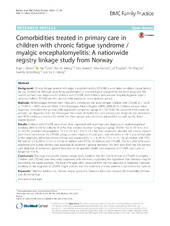| dc.contributor.author | Bakken, Inger Johanne | en_US |
| dc.contributor.author | Tveito, Kari | en_US |
| dc.contributor.author | Aaberg, Kari Modalsli | en_US |
| dc.contributor.author | Ghaderi, Sara | en_US |
| dc.contributor.author | Gunnes, Nina | en_US |
| dc.contributor.author | Trogstad, Lill | en_US |
| dc.contributor.author | Magnus, Per | en_US |
| dc.contributor.author | Stoltenberg, Camilla | en_US |
| dc.contributor.author | Håberg, Siri Eldevik | en_US |
| dc.date.accessioned | 2016-11-25T12:43:52Z | |
| dc.date.available | 2016-11-25T12:43:52Z | |
| dc.date.issued | 2016-09-02 | |
| dc.Published | BMC Family Practice 2016, 17:128 | eng |
| dc.identifier.issn | 1471-2296 | |
| dc.identifier.uri | https://hdl.handle.net/1956/13125 | |
| dc.description.abstract | Background: Chronic fatigue syndrome/myalgic encephalomyelitis (CFS/ME) is a complex condition. Causal factors are not established, although underlying psychological or immunological susceptibility has been proposed. We studied primary care diagnoses for children with CFS/ME, with children with another hospital diagnosis (type 1 diabetes mellitus [T1DM]) and the general child population as comparison groups. Methods: All Norwegian children born 1992–2012 constituted the study sample. Children with CFS/ME (n = 1670) or T1DM (n = 4937) were identified in the Norwegian Patient Register (NPR) (2008-2014). Children without either diagnosis constituted the general child population comparison group (n = 1337508). We obtained information on primary care diagnoses from the Norwegian Directorate of Health. For each primary care diagnosis, the proportion and 99 % confidence interval (CI) within the three groups was calculated, adjusted for sex and age by direct standardization. Results: Children with CFS/ME were more often registered with a primary care diagnosis of weakness/general tiredness (89.9 % [99 % CI 88.0 to 91.8 %]) than children in either comparison group (T1DM: 14.5 % [99 % CI: 13.1 to 16.0 %], general child population: 11.1 % [99 % CI: 11.0 to 11.2 %]). Also, depressive disorder and anxiety disorder were more common in the CFS/ME group, as were migraine, muscle pain, and infections. In the 2 year period prior to the diagnoses, infectious mononucleosis was registered for 11.1 % (99 % CI 9.1 to 13.1 %) of children with CFS/ ME and for 0.5 % (99 % CI (0.2 to 0.8 %) of children with T1DM. Of children with CFS/ME, 74.6 % (1292/1670) were registered with a prior primary care diagnosis of weakness / general tiredness. The time span from the first primary care diagnosis of weakness / general tiredness to the specialist health care diagnosis of CFS/ME was 1 year or longer for 47.8 %. Conclusions: This large nationwide registry linkage study confirms that the clinical picture in CFS/ME is complex. Children with CFS/ME were frequently diagnosed with infections, supporting the hypothesis that infections may be involved in the causal pathway. The long time span often observed from the first diagnosis of weakness / general tiredness to the diagnosis of CFS/ME might indicate that the treatment of these patients is sometimes not optimal. | en_US |
| dc.language.iso | eng | eng |
| dc.publisher | BioMed Central | eng |
| dc.relation.uri | https://www.ncbi.nlm.nih.gov/pmc/articles/PMC5010760/pdf/12875_2016_Article_527.pdf | |
| dc.rights | Attribution CC BY | eng |
| dc.rights.uri | http://creativecommons.org/licenses/by/4.0 | eng |
| dc.subject | Children | eng |
| dc.subject | Adolescents | eng |
| dc.subject | Chronic fatigue syndrome | eng |
| dc.subject | Diabetes | eng |
| dc.subject | Infections diseases | eng |
| dc.subject | Multimorbidity | eng |
| dc.subject | Primary care | eng |
| dc.subject | Epidemiology | eng |
| dc.title | Comorbidities treated in primary care in children with chronic fatigue syndrome | en_US |
| dc.type | Peer reviewed | |
| dc.type | Journal article | |
| dc.date.updated | 2016-09-16T09:16:02Z | |
| dc.description.version | publishedVersion | en_US |
| dc.rights.holder | Copyright 2016 The Authors | |
| dc.identifier.doi | https://doi.org/10.1186/s12875-016-0527-7 | |
| dc.identifier.cristin | 1382061 | |

